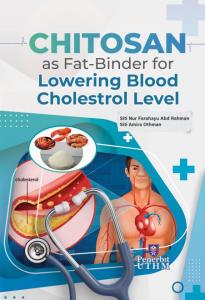Chitosan as Fat-Binder for Lowering Blood Cholesterol Level
Keywords:
Lowering Blood, Cholesterol LevelSynopsis
Chitosan is a natural polysaccharide produced by the deacetylation of chitin, a significant component of crustaceans’ shells such as crabs, shrimp, lobster and crawfish. Chitosan can be modified to become hydrophobic, which means the lack of affinity to water increases hydrophobicity properties. Through hydrophobic bonds, it is claimed to have the ability to bind with neutral lipids such as cholesterol. Cholesterol is a type of fat essential for humans, but too high a cholesterol level can be dangerous. Thus, this study aims to observe the parameters that can enhance hydrophobically modified chitosan’s ability to lower cholesterol levels. The monitored parameters include the concentration of chitosan, the different pH values and the type of cooking oil. Another research objective is to study the effect of gamma radiation on samples. The method used to determine how much cholesterol is entrapped by the chitosan is quantifying the entrapped oil method. In contrast, the characteristics of cooking oil droplets formed can be observed through MBI-1600X microscope, UV-visible spectroscopy, Fourier Transform Infrared Spectroscopy (FTIR) and Field Emission Scanning Electron Microscope (FESEM). Finally, the interaction between chitosan and cooking oil at those three parameters, including gamma radiations effect on samples, is determined. This book is written to suit the needs of readers who want to know more about the properties characterisation of chitosan.
Downloads
References
Azeman, N.H., Yusof, N.A., Abdullah, J., Yunus, R., Hamidon, M.H. & Hajian, R. (2015). Study on the Spectrophotometric Detection of Free Fatty Acids in Palm Oil Utilizing Enzymatic Reactions. Molecules, 20, 12328-12340.
Bani, K., Montazeri, M. & Hashemi, M. (2006). Effect of Palm Oil on Serum Lipid Profile in Rats. Pakistan Journal of Nutrition, 3, 234-236.
Copikova, J., Taubner, T., Tuma, J., Synytsya, A., Duskova, D. & Marounek, M. (2014). Cholesterol and Fat Lowering with
Hydrophobic Polysaccharide Derivatives. Carbohydrates Polymers, 116, 207-214.
Desbrieres, J., Martinez, C. & Rinaudo, M. (1996). Hydrophobic Derivatives of Chitosan:Characterization and Rheological Behaviour. International Journal of Biological Macromolecules, 21-28.
Dutta, P.K., Dutta, J. & Tripathi, V.S. (2004). Chitin and Chitosan:Chemistry, Properties and Applications. Journal of Scientific & Industrial Research, 20-31.
Fray, M.E., Niemczyk, A. & Parbin-Szafko, B. (2012). Chemical Modification of Chitosan with Fatty Acids. Progress on
Chemistry and Application of Chitin and Its Derivatives, Volume XVII.
Guan, L., Chung, H.Y. & Chen, Z.Y. (2011). Comparison of Hypocholesterolemic Activity of Tea Seed Oil with Commonly
Used Vegetable Oils in Hamster. Journal of Food Biochemistry, 859-876.
Hettiarachchi, M.A. & Wickramarachchi, P.A.S.R. (2011). Synthesis of Chitosan Stabilized Silver Nanoparticles using Gamma Ray Irradiation and Characterization. Journal Science of University Kelaniya, 6, 65-75.




